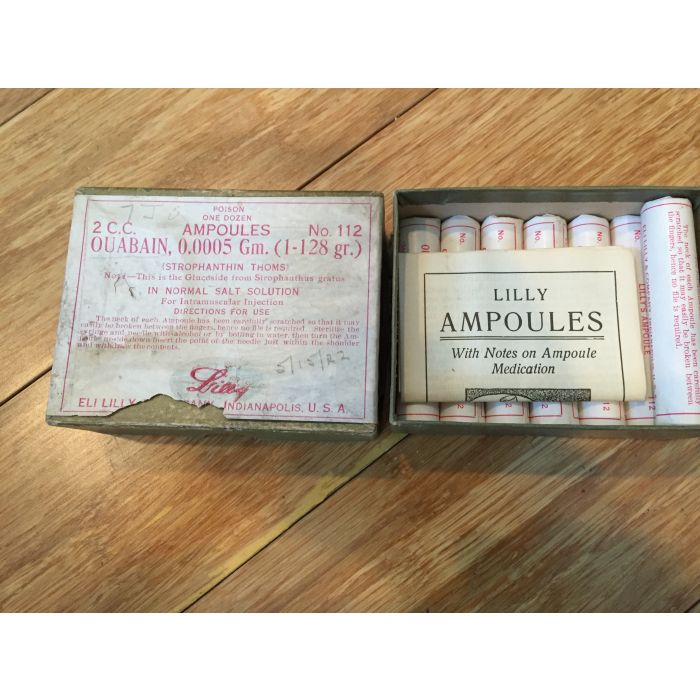Vintage antique Ouabain Ampoules Strophanthin Eli Lilly 7-2cc Amps and Outer Carton
$24.95
Out of stock
SKU
500011
Vintage antique Ouabain Ampoules Strophanthin Eli Lilly 7-2cc Amps and Outer Carton
7 Individually Packaged amps in 12amp Box Dated 5/15/22. With Flyer "Notes On Ampoule Medication".
Vintage antique Ouabain Ampoules Strophanthin Eli Lilly 7-2cc Amps and Outer Carton
7 Individually Packaged amps in 12amp Box Dated 5/15/22. With Flyer "Notes On Ampoule Medication".
Ouabain /ˈwɑːbɑːɪn/,[1] /wɑːˈbɑːɪn/ or /ˈwɑːbeɪn/ (from Somali waabaayo, "arrow poison" through French ouabaïo) also known as g-strophanthin, is a cardiac glycoside. Sometimes used in the treatment of heart conditions, it has also been used as a powerful arrow poison by some tribal people.
Ouabain (g-strophanthin) is found in the ripe seeds of African plants Strophanthus gratus and the bark of Acokanthera ouabaio.
From Wiki:
It is well understood that the classical mechanism of action of ouabain involves its binding to and inhibition of the plasma membrane Na+/K+-ATPase (sodium/potassium pump) especially at the higher concentrations attainable in vitro or with intravenous dosage. Inhibition of the sodium pump and the secondary effect on the handling of calcium ions by sodium calcium exchanger (NCX) is widely believed to underlie the original beneficial effect as an inotropic agent following intravenous use of ouabain; digoxin is a structurally related and more lipophilic cardiac glycoside that largely replaced ouabain for therapy because of its superior oral bioavailability. Digoxin continues to be used therapeutically for many of the same indications in which ouabain was used (including atrial fibrillation and congestive heart failure).
In addition to the classical mechanism of action of ouabain at high concentrations, low (nanomolar and subnanomolar) concentrations of ouabain, as they were found endogenously (see below) or after oral intake, stimulate the Na-K-ATPase.[2] This stimulatory effect does not appear to be mimicked by digoxin.[3] Furthermore ouabain acts as a signal transducer.[4]
Endogenous ouabain and ouabain mimics[edit]
In 1991, a potent sodium pump inhibitor was isolated from the human circulation and identified as ouabain. Several additional observations led to the view that the circulating ouabain in humans was an endogenous hormone.[5] A reinterpretation of a portion of the analytical data led to the proposal that endogenous ouabain may have been the 11 epimer, i.e., an isomer of plant ouabain.[6] However, this possibility has been excluded by the synthesis of the 11 epimer and the demonstration that it has different chromatographic behavior from ouabain. There is compelling analytical evidence that ouabain is synthesized in the adrenal gland.[7] A ouabain-like factor may also be made in the hypothalamus[8] and possibly the heart where it may be stimulated by oxygen deficiency.[9] In the latter instances, analytical data are needed to support the identity of the secreted materials. Further, secretion is not equivalent to biosynthesis; most all (most or all?) tissues sequester ouabain from the circulation. When such tissues are removed from the circulation they secrete ouabain but this phenomenon, by itself, is not proof of biosynthesis.
New findings indicate that ouabain is not an endogenous hormone. Research results suggest that immunoassays previously used to quantify assumed endogenous ouabain detected compounds which are not structurally identical with ouabain. Cross reactivity of structurally related compounds of endogenous origin may cause these discrepancies between immunological and mass spectrometric analyses.[10]
Uses[edit]
Extracts containing ouabain have long been used by Somali tribesmen and other groups to poison hunting arrows.[11] A sufficiently concentrated ouabain dart can bring down a hippopotamus, probably as the result of respiratory and/or cardiac arrest.
In France and Germany, intravenous ouabain has a long history in the treatment of heart failure, and some continue to advocate its use intravenously and per os (orally) in angina pectoris and myocardial infarction. The positive properties of ouabain regarding the prophylaxis and treatment of these two indications are documented by a clutch of studies.[12] Ouabain isolated from plants is widely used by scientists in in vitro studies to specifically block the sodium pump (Na-K-ATPase). In many non-rodent species, low concentrations of this substance (i.e., in the subnanomolar range) may stimulate the Na-K-ATPase. The mechanism of the stimulatory effect is not understood and remains controversial. Further, the issue in rodents is more complicated because there are different isoforms of the Na-K-ATPase - some of which are very sensitive to ouabain while others are not.
The parenteral absorption seems to be better than indicated by the textbooks.[12]
Recently, use of ouabain as a contraceptive has been investigated, showing that it can severely decrease the motility of spermatozoa.[13]
The African crested rat smears toxins on its flank hairs
The African crested rat (Lophiomys imhausi) has a broad, white-bordered strip of hairs covering an area of glandular skin on the flank. When the animal is threatened or excited, the mane on its back erects and this flank strip parts, exposing the glandular area. The hairs in this flank area are highly specialised; at the tips they are like ordinary hairs, but are otherwise spongy, fibrous, and absorbent. The rat is known to deliberately chew the roots and bark of the Poison-arrow tree (Acokanthera schimperi), which contains ouabain. After the rat has chewed the tree, it deliberately slathers the resulting mixture onto its specialised flank hairs which are adapted to rapidly absorb the poisonous mixture, acting like a lamp wick. It thereby creates a defense mechanism that can sicken or even kill predators which attempt to bite it
Write Your Own Review

